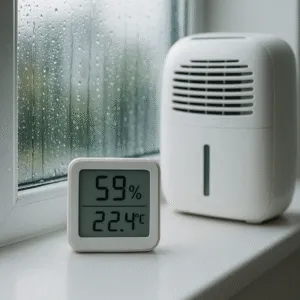
Window Fogging: Why It Happens and How to Effectively Prevent It
Window fogging is a phenomenon many of us are familiar with in everyday life – it appears on windows in homes and on car windshields. Although it’s a natural process based on the laws of physics, it can become annoying or even damaging if it occurs frequently or excessively. It’s worth understanding why windows fog up and what effective methods can be used to prevent it.
Causes of Window Fogging
Window fogging is the result of condensation of water vapor in the air on the cool surface of the glass. Water vapor is water in its gaseous state, and it’s always present in the air. The amount of vapor the air can hold depends on its temperature – warm air can hold much more moisture than cold air. When humid air comes into contact with a cold window, the air temperature near the surface drops below what’s called the dew point, which causes the moisture to condense into droplets on the glass.
In home environments, window fogging is often linked to high humidity caused by everyday activities such as cooking, drying laundry, or showering. In modern, well-insulated and airtight buildings, this problem is exacerbated because a lack of proper ventilation leads to moisture accumulation indoors. In such conditions, the water vapor has nowhere to escape, and cold window surfaces become the prime location for condensation.
Fogging can occur in three main areas:
- On the exterior surface of the glass – This is a natural and usually harmless occurrence, especially during autumn and winter when it’s cold outside and humidity levels are high.
- Inside the glass unit (between panes) – This indicates a fault in the seal of the insulated glass unit. Moisture in this space signals a loss of airtightness, which leads to reduced thermal insulation and faster degradation of the window.
- On the interior surface of the glass – This is a more serious issue because it can lead to damp walls and mold growth, which negatively affects the health of occupants and the integrity of the building.
Why Is Window Fogging a Problem?
Window fogging – especially on the inside – is not just an aesthetic issue. Excess moisture leads to damp walls and mold growth, which can trigger allergies and respiratory conditions. Additionally, moisture degrades window seals and wall components, reducing the building’s thermal comfort and structural durability over time.
In modern airtight and well-insulated homes, window fogging often becomes apparent after window replacement or building insulation, as existing gravity ventilation becomes insufficient. In these cases, improving air circulation is essential.
How to Effectively Combat Window Fogging
1. Improve Ventilation
The most important step is to ensure proper ventilation to exchange moist air for fresh, dry air. This can be achieved through:
- Installing window trickle vents or air inlets that allow controlled airflow without fully opening the window.
- Using windows with micro-ventilation features, which enable a steady, low-level airflow to reduce condensation risk.
- Regularly ventilating rooms by opening windows, especially during cooking or laundry drying.
2. Choose the Right Windows and Glazing
- Use insulated glazing units with a low thermal transmittance (U-value), ideally triple-glazed units, which offer better insulation and are less prone to fogging.
- Pay attention to the type of spacers between panes – modern warm-edge spacers reduce thermal bridging that encourages condensation.
- Replace old seals with new ones made of durable materials like EPDM synthetic rubber, which provides better insulation and prevents cold air from entering.
3. Control Indoor Humidity
- Reduce moisture sources by using kitchen exhaust hoods, drying clothes outside or in well-ventilated rooms.
- Use dehumidifiers in areas with high humidity levels.
4. Regular Window Maintenance
- Check seals and hardware regularly, as they can affect the window’s airtightness and thermal insulation.
- Repair or replace any defective parts of the window joinery as needed.
Summary
Window fogging is a natural occurrence caused by the physics of humid air and temperature differences. However, when it happens frequently or in large amounts, it can pose a significant health and technical problem. The key to addressing it lies in proper ventilation, selecting the right windows and glazing, and maintaining appropriate indoor humidity levels. Modern solutions, such as micro-ventilation windows or triple-glazed units with low U-values, greatly reduce the risk of fogging and enhance indoor comfort.
By taking a proactive approach to window fogging, you can enjoy a warm, dry, and healthy home without the nuisance of condensation.
Sources:
[1] https://ekookna.pl/ekopl/zasob-wiedzy/skraplanie-sie-wody-na-oknach
[2] https://sklep.hurtania.pl/blog/139/parowanie-szyb-w-aucie-sposob-na-zaparowane-szyby-podczas-deszczu
[3] https://constans.pl/dlaczego-moje-okna-paruja.html
[4] https://oknoplast.com.pl/leksykon/mikrowentylacja-w-oknach/
[5] https://www.kapica.pl/blog/2020/08/10/parowanie-okien-przyczyny-i-sposoby-radzenia-sobie-z-problemem/
[6] https://autoglass.com.pl/blog/dlaczego-szyba-samochodowa-moze-parowac-i-jak-temu-zapobiec/
[7] https://www.mazda.pl/filozofia-mazdy/aktualnosci-i-wydarzenia/porady/parujace-szyby-w-aucie-jak-temu-zapobiec/
[8] https://cuk.pl/porady/parowanie-szyb-w-samochodzie
[9] https://sonax.katowice.pl/content/24-jak-zapobiegac-parowaniu-szyb-w-samochodzie
[10] https://intercars.pl/blog/poradnik-kierowcy/zaparowane-szyby-w-samochodzie-cieply-czy-zimny-nawiew-jako-rozwiazanie/

